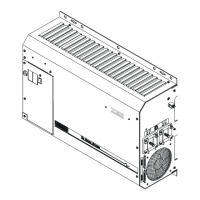TECHNICAL INFORMATION
Page
98
Copyright Trace Engineering Company, Inc.
5916 - 195th Street N.E.
Arlington, WA 98223
Telephone: 360/435-8826
Fax: 360/435-2229
www.traceengineering.com
PS Series Inverter/Charger
Part No. 3597
Rev. D: November 23, 1999
EXAMPLE
Complete the steps that follow to calculate your battery bank capacity. No two installations will require
exactly the same battery bank capacity. The example that follows will provide a guideline for determining
your needs. Read through the example and then complete the worksheet on the following page.
STEP 1-4: Determine your Average Daily Watt-Hours Needed.
STEP 1 STEP 2 STEP 3 STEP 4
AC APPLIANCE
APPLIANCE RUNNING
WATTS
(X) HOURS USED
EACH DAY
(X) DAYS USED
EACH WEEK
(÷ 7 = ) AVERAGE DAILY
WATT-HOURS NEEDED
Microwave 600 0.5 7 300
Lights (x4) 40 6 7 240
Hair Dryer 750 0.25 3 81
Television 100 4 7 400
Washer 375 1 2 107
Refrigerator* 480/3 = 160 24 7 3840
Vacuum cleaner 1200 1 1 171
STEP 1: Determine what appliances the inverter will power and enter the Appliance Running
Wattage of each appliance.
* Refrigerators and icemakers typically only run about 1/3 of the time, therefore the running
wattage is 1/3 of the total wattage of the appliance.
STEP 2: Determine the number of hours (or fractions of hours) you will use the appliance each day;
STEP 3: Multiply the number of days you will use the appliance during the week; this is your Weekly
Watt-Hours Needed;
Needed;
STEP 5: Total Average Daily Watt-Hours Needed to determine your Total Daily
Watt-Hours Needed.
Total Daily Watt-Hours Needed
5,139
STEP 6: Multiply your Total Daily Watt-Hours Needed (Step 5) by the number
of anticipated days of autonomy (days between charging, usually 1 to
5) to determine your Autonomy Battery Size (example used 3 days).
Autonomy Battery Size
15,417
STEP 7: Multiply your Autonomy Battery Estimate (Step 6) x 2 to allow for a
50% maximum battery discharge in normal operation and an
additional 50% for emergency situations to obtain your Rough Battery
Size in watt-hours.
Rough Battery Size Watt-Hours
30,834
STEP 8: Determine your Safe Battery Size in watt-hours. Multiply your Rough
Battery Estimate x 1.2. This allows for an efficiency of 80%. This
number is your Safe Battery Size in watt-hours
Safe Battery Size (Watt-Hours)
37,001
STEP 9: Convert your Safe Battery Size to amp-hours. Divide Safe Battery
Size by the DC system voltage (i.e., 12, 24 or 48 VDC; example used
24-volts). This number is your Safe Battery Size in amp-hours, which
is the battery bank capacity needed before recharging.
Safe Battery Size (Amp-Hours)
1,542

